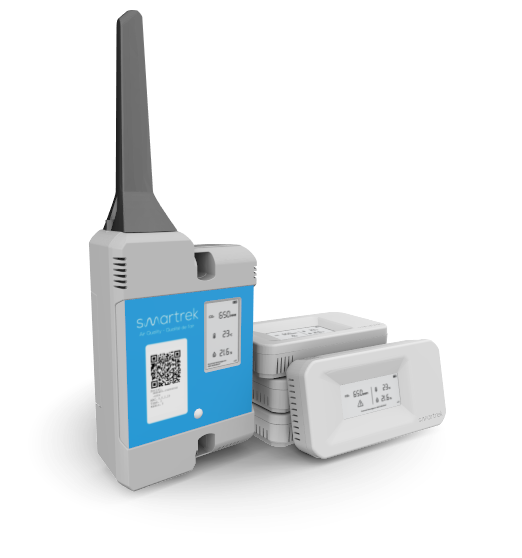Why is it important to monitor IAQ? – Smartrek Technologies Inc. to the rescue of indoor air quality (IAQ)
In recent years, the international scientific community, political institutions, and environmental authorities have paid particular attention to indoor air quality (IAQ). Moreover, the SARS-CoV-2 virus has only accentuated this trend.
The consequences and risks of neglecting indoor air quality
The repercussions of constant exposure to air pollution in our indoor spaces can be more significant than those related to outdoor pollution. The average person spends almost 90% of their time indoors in a closed environment where the indoor air quality can be two to five times more harmful than outdoors.
Long-term exposure to poor Indoor Air Quality (IAQ) can affect human health, comfort, well-being, and productivity. Studies in several European countries have shown that these symptoms affect more than one-third of employees working in confined spaces. In the United States alone, it is estimated that lost employee productivity costs businesses more than $75 billion annually.
Typical symptoms include headaches, eye irritation, dry cough, and itchy skin. It can increase the risk of chronic health problems, including cardiovascular disease and chronic obstructive pulmonary disease, in severe cases.

Get information about your ventilation by measuring the carbon dioxide (Co2) in your environment.
Ventilation plays an essential role in ensuring a healthy indoor environment for employees, students, etc. To acquire valuable information and adapt the ventilation according to the needs, it is possible to measure the concentration of carbon dioxide inside the closed environment. However, the data must be interpreted with great care. To implement a practical approach, it is essential to emphasize the monitoring and management of the implemented tools.
It is increasingly vital to implement Indoor Air Quality (IAQ) policies in all enclosed spaces (schools, offices, laboratories, public transportation..). In addition, there are now sensors capable of providing real-time data, whose mission is to allow us to act accordingly.
We invite all managers to take advantage of the technological and strategic tools available to give employees, students, etc… the confidence to return to work/study with peace of mind.
Increase fresh air supply to limit the spread of COVID-19
Numerous studies have shown that the SARS-CoV-2 virus is spread primarily through the air by respiratory droplets when a person coughs, sneezes or talks. Fortunately, due to their weight, they quickly fall to the ground or a nearby surface.
Therefore opening windows or leaving ventilation on 24/7 is not a beneficial solution. However, there are many strategies to minimize the spread of airborne viruses.
Consider an environment such as an office, where the air is dry. Because of this factor, the droplets will evaporate quickly and fall more slowly, and remain in the air longer. This is the worst possible scenario. In this particular context, Smartrek Indoor Air Quality (IAQ) monitors act accordingly. When humidity or temperature fluctuates, you’ll receive alerts, allowing you to take the appropriate action for the situation.
Research has shown that in low humidity environments, the efficiency of the virus is 74%, compared to about 18% when optimized.
Calculate the CO2 level to fight against the spread of COVID-19
According to a study conducted by the University of Colorado, the risk of COVID transmission increases threefold when the CO2 level in a closed environment rises from 800 to 1600 ppm.
This is one reason why increased monitoring of CO2 levels is now being used as an indicator of infection risk.
To provide a turnkey solution, Smartrek developed a state-of-the-art monitor combined with its wireless technology, SpiderMesh, to connect sensors efficiently and accurately.
Our sensors have proven themselves, and today we have over 30,000 devices installed across Canada, providing clean air and a safe environment for over 500,000 people.

Leave A Comment